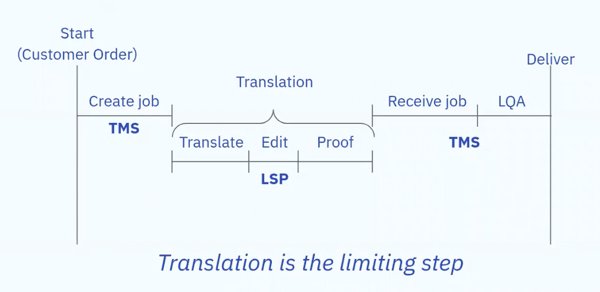Scaling Localization Through AI and Automation: A Recap

These days, AI and automation are two topics that are taking the world by storm. Many industries, from manufacturing to real estate, are thinking about how to implement processes to speed up productivity and eliminate unnecessary manual work.
We recently hosted a webinar, Scaling Localization With AI and Automation, hosted by Lilt CEO Spence Green. He touched on exactly that - how AI and automation have slowly grown in our everyday lives and, more specifically, how they both live in the world of localization. At Lilt, we’ve seen the power of automation in localization, whether it’s a 70% reduction in translation errors, a 3-5x increase in translation throughput, or a 50% reduction in cost of human translation.
But first, it’s important to look at AI and automation more broadly. In the last few decades, both have claimed their places in our day-to-day lives.
The Future of Work: Where We Are and What's to Come
In some industries, the future of work has already changed through automation in impressive ways. One of the early and common examples of this is in customer support call centers. Calling into a business support line often resulted in small pieces of conversation surrounded by minutes of silence while an agent tried to research and better understand the problem. In fact, it’s estimated that up to 75% of an agent’s time on a service call was spent doing manual work. These days, you’re more likely to speak through a number of automated speech recognition menus that wind up routing you to skill-based agents. It’s more efficient, and winds up wasting less agent time doing work that could (and should) be automated.
On the other hand, we’re only in the infancy of automation in the automotive industry. The often referenced levels of automotive automation describe the varying degrees of human interaction while driving. While the dream of the 1960s was to have self-driving taxis and futuristic robotic cars, we’re now only coming around to Level 2 (Partial Automation) on the five-level scale. Most cars these days operate with Level 1 features - driving assistance options like cruise control, parking cameras, lane following technology, and more. Even though cars in 2020 are far from being described as fully automated, it’s clear that the future of the automotive industry is AI.
Bringing Automation to Localization
Localization is not immune to the power of AI and automation, nor should it be. Spence points to the Basics of Production, written about in the 1983 book High Output Management. In the book, former chairman and CEO of Intel Andrew S. Grove uses an example of “The Breakfast Factory” - a production line tasked with serving a soft-boiled egg, toast, and coffee. Sounds simple enough, right? The objective, however, is to deliver the three items simultaneously, while serving them fresh and hot.
How does breakfast relate to localization? The production process in localization is very similar to the above example. Generally, teams use a TMS to create a job, work with an LSP to translate content, send it back to their TMS, then deliver the final product. However, there is a limiting step. In the case of localization, translation is the limit, as it generally takes the longest to produce. As Grove wrote, the goal of any production line is to “deliver products in response to the customer at a scheduled time, at an acceptable quality level, and at the lowest possible cost.”
So why is automation key for localization, and how can we automate the limiting factors to make the process as effective as possible? Spence says first, we need to understand our localization objectives. While quality, budget, and time are all important factors, reach is actually the key goal to keep in mind.
Reach encapsulates quality, budget, and time into one. “We want to maximize the number of high quality words that are produced given that we have a fixed budget,” Spence says. “That’s the setting that most people running localization find themselves in.” Optimizing the total cost-per-word (CPW) can help maximize reach. The best way to optimize for CPW is to analyze current processes and see where potential opportunities for savings are. Spence points to three main areas of analysis: Internal Teams, Software, and Translation Services.
To learn what business questions to ask, learn how to calculate potential savings, and understand more about objective planning, watch the full Scaling Localization with AI and Automation webinar by clicking this link.

.png)

.jpeg)
